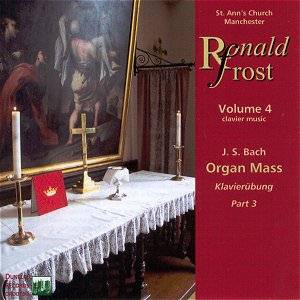Comparison recordings: Ton Koopmann, Anthony Newman,
Michel Chapuis, Lionel Rogg.
Organist Frost performs this work with a new twist,
grouping the three-manual organ works together between the Prelude BWV
522/a and the Fugue BWV 522/b (Sometimes called "the St. Anne"
for no good reason*) to provide a version of the Organ Mass for large
organ. Then he plays those parts of the music suitable for two manual
organ (or two hands on a single keyboard) on the organ and/or clavichord
as an appendix on the second disk, again between the prelude and the
fugue, to provide a version of the Mass as it might be heard in a church
with a smaller two manual organ. Those who wish to program their cd
players to present the music in the original published sequence will
thus find it convenient that the Fugue repeated at the end of disk two.
Frost omits the four duets (BWV 802-805) which were included in Klavierübung
III, but are generally not considered to be part of the organ mass,
although Harry Halbreich writing in the notes to the Chapuis recording
suggests that they could represent the four Gospels.**
Ronald Frost achieves something truly remarkable hereóhe
plays the organ lyrically, and makes this music sound easy to play,
which it most certainly is not. The other organists to whose recordings
I compared build musical interest through a variety of contrasting registrations,
some of them abrasive, even bizarre. Frost uses a smaller range of registrations
and focuses attention on the musicís melodic qualities. Let it be said,
he presents this music as it is used liturgically at St. Annís. To underscore
this, the liturgical application of each piece is indicated in the margin
of the notes. Since that is how the music was originally intended, it
is a perfectly valid way to approach it. But there is nothing "churchy"
in this performance, in fact due to the sounds of the individual voices
being more equal, it is easier to hear them all at once and to perceive
the contrapuntal structure of the music than it is when one voice is
highlighted on a nasal or reed stop, as is often the case with other
organists. The comparison recordings are all analogue, so Frostís digital
sound is clearly the best, not too close, not too reverberant, the individual
voices clearly audible. There is some slight wind noise.
Frostís tempi are generally midway between extremes.
For instance on the Prelude BWV552/a, Anthony Newman clocks in at 7.22,
Michel Chapuis at 8.10, Ton Koopman at 9.25, Lionel Rogg at 9:36óand
Frost at 8.32. On BWV 673, the timings are: Rogg 1.38, Frost (organ)
1.33, Frost (clavichord) 1.19, Koopman 1.09, Chapuis 1.09, Newman 0.52.
Although the specific ranking changes, Frostís tempi remain in the middle
of the range. Frostís performances on the clavichord are all faster
than his performances of the same works on the two organ manuals.
This set is also unusual in another way: at least the
review copy disks were recorded individually on CDRs and the notes and
disk labels were printed individually on a computer printer. This allows
the production of disks exactly as the demand arises, a low capital
investment approach that makes it feasible for individuals (and churches)
to operate their own record labels. It seems that these disks will be
sold in the Church souvenir shop along with other disks of organ recitals.
There is no reason to feel that CDRís are significantly less durable
in normal handling than regular pressed CDs, although our Alsatian was
once able to cause a recorded CDR to delaminate in the process of his
chewing it to bits.
I owned a clavichord and struggled to play it for thirty
years and know that the clavichord is all but unplayable and virtually
unrecordable. A number of famous keyboardists have produced for reputable
recording companies some awful clavichord recordings which do not begin
to approximate the actual sound or experience of playing this instrument.
Keyboard training on the modern piano is not the best approach to the
clavichord; performance on the Japanese koto would be more to
the point. Like the koto, the clavichord is capable of portamentos
and free vibrato which allows one to play a singing line of almost vocalic
purity and grace. The sound should arise from the strings effortlessly.
But most modern clavichord recordings are full of clang and clatter,
the uncontrolled waveriness of tone simply sounding sour and out of
tune. For these reasons, I believe that only by synthesizing the sound
can the experience of playing the claivichord be reproduced on disk.
Ronald Frost is as good a performer at the clavichord as Ralph Kirkpatrick
and Thurston Dart were. If someday a true clavichord virtuoso arises,
he or she will startle the record buying public by producing a sound
only clavichord owners have ever heard or even imagined before.
The organ at St. Annís was rebuilt and enlarged in
1995-1996. With typical stiff-upper-lip British reserve, there is a
brief note in fine print to the effect that the terrorist bomb attack
which destroyed several large buildings in downtown Manchester on 15
July 1996, "delayed" the re-installation of the rebuilt organ
due to the ancillary decoration of the Church, located only a few blocks
from the center of the blast, having to be "repeated."
*As with many of Bachís works, the main overall motive
of the Prelude is Wie schön leuchtet der Morgenstern, so
perhaps it is not inappropriate that it begin a mass.
**Spitta, Schweitzer, Schmieder, et al have
questioned the presence of the four duets, but they are no more out
of place here than the Prelude and Fugue. If the one is included, why
not the other?
Paul Shoemaker
